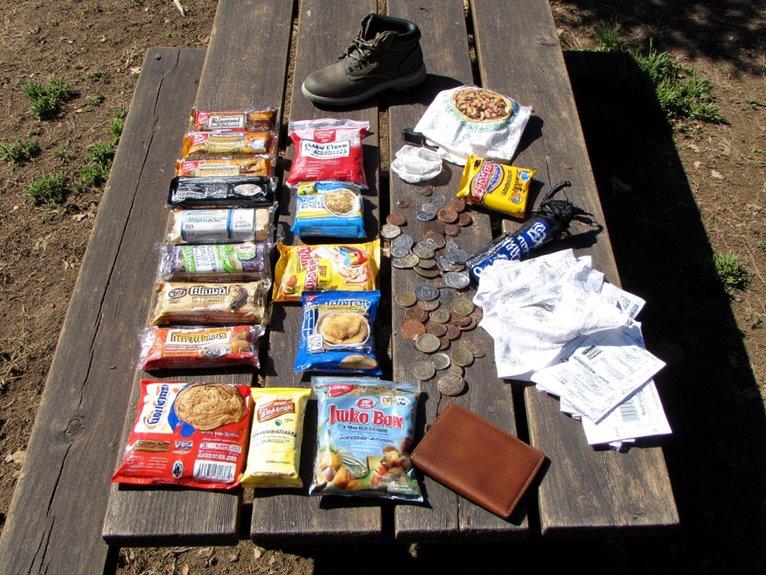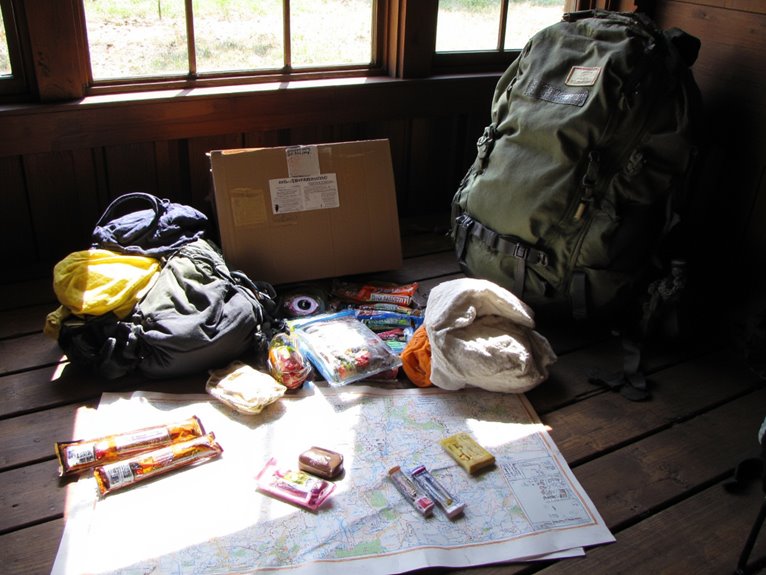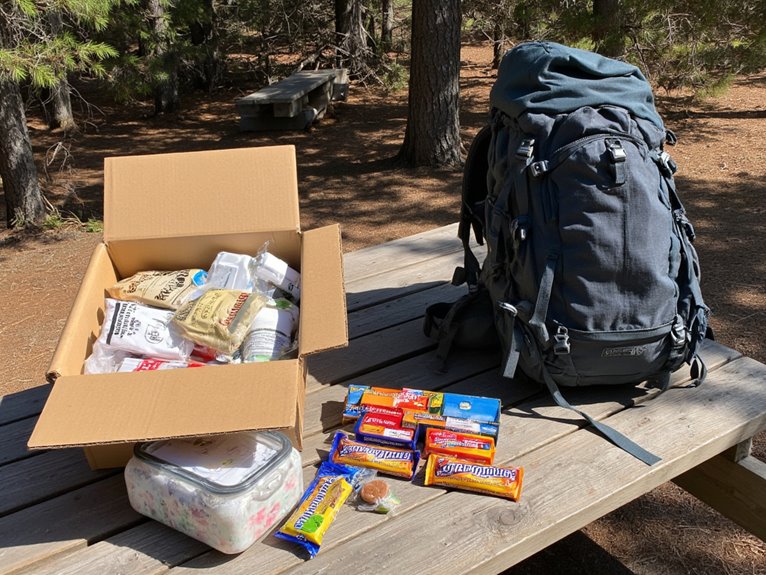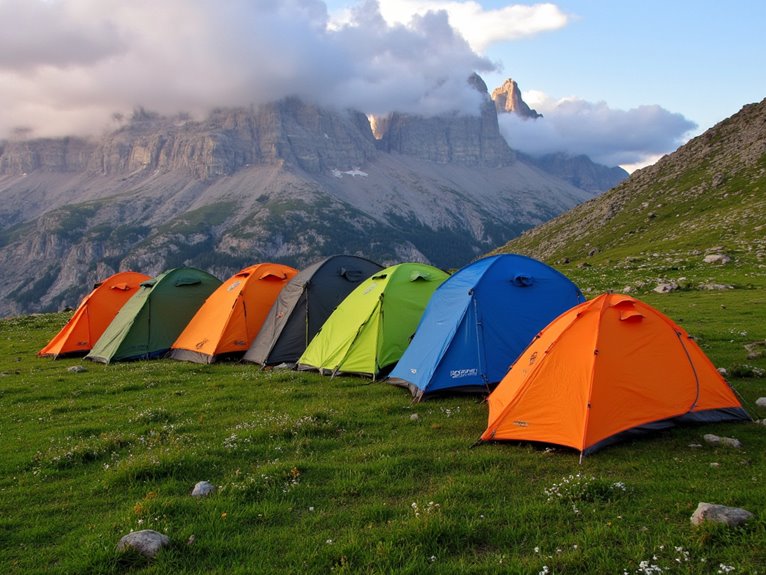Resupply Strategy for Long-Distance Hiking: Mail Drops vs. Town Stops
You’ll need to choose between mail drops and town stops based on your hiking priorities and budget constraints. Mail drops cost $16-21 per shipment but guarantee specific nutrition and gear access in remote areas where stores are 100-150 miles apart. Town stops average $9.70 daily and offer real-time flexibility for adjusting supplies based on trail conditions. Remote sections require mail drops for 7-10 day intervals, while populated areas benefit from town resupply spontaneity. A hybrid approach combining both methods maximizes your logistical advantages and emergency preparedness options.
We are supported by our audience. When you purchase through links on our site, we may earn an affiliate commission, at no extra cost for you. Learn more. Last update on 13th November 2025 / Images from Amazon Product Advertising API.
Notable Insights
- Mail drops require detailed advance planning and precise addressing but provide better food variety and cost savings through bulk purchasing.
- Town stops offer maximum flexibility for real-time adjustments based on trail conditions but average $9.70 per person daily.
- Remote wilderness sections with 100-150 mile gaps between stores make mail drops essential for 7-10 day resupply intervals.
- A hybrid strategy combining both methods maximizes flexibility while ensuring reliable nutrition and emergency preparedness in challenging terrains.
- Mail drops risk package loss and timing issues, while town stops face potential inventory shortages and premium markups.
Understanding Mail Drop Fundamentals
When you’re planning a long-distance hike, mail drops function as strategic supply caches that deliver essential gear and provisions to predetermined locations along your route.
Strategic supply caches positioned along your hiking route ensure you receive essential gear and provisions exactly when and where needed.
You’ll send pre-packaged boxes to specific post offices or designated drop points ahead of your arrival. Proper mail drop organization requires maintaining detailed lists of all locations and contents to prevent confusion and missed packages.
You must use accurate addressing with correct zip codes, as similar town names frequently cause delivery errors. Holiday schedules affect post office hours, potentially delaying access to your supplies.
While mail drops enhance food variety by providing specialized items unavailable in small trail towns, limit food quantities unless you follow specific dietary requirements. Most resupply points offer adequate standard food options for general hiking needs. You can practice portion control by dividing the contents of your mail drop box into manageable serving sizes. You’ll need to present a government-issued photo ID that exactly matches the name on your mail drop box to retrieve your package.
Exploring Town Stop Advantages
Town stops offer critical flexibility that mail drops can’t match—you can adjust your resupply based on actual trail conditions, weather changes, and your body’s current nutritional needs.
This spontaneous decision-making capability becomes essential when you’re craving fresh produce after days of dried meals or need to increase calorie density due to unexpected cold weather.
Your spending in trail towns directly supports the local businesses and communities that maintain the infrastructure hikers depend on, creating a sustainable economic relationship that benefits both parties. These town interactions provide opportunities to connect with fellow hikers who share similar goals and experiences. By choosing accommodations close to laundries and breakfast options, you can streamline your town visits and maximize efficiency.
Flexibility and Spontaneous Decisions
How often do hikers find themselves locked into rigid schedules that don’t account for unexpected trail conditions or personal needs? Town stops offer increased spontaneity that mail drops simply can’t match.
You can make immediate itinerary adjustments based on weather forecasts, physical condition, or trail closures without waiting for predetermined packages.
This flexibility extends beyond schedule changes. You’ll access local transportation options like hitchhiking or rideshares for unplanned side trips.
Trail routes like the Appalachian Trail position towns close enough to minimize detours while maximizing logistical freedom. Many hikers find that pre-prepared boxes may not align with food preferences that develop along the trail, making spontaneous town shopping more appealing. Trail towns provide essential services and serve as vital resupply points for long-distance hikers throughout their journey.
On-the-go decision-making becomes practical when supplies, information, and amenities are immediately available. Just as hikers need flexibility with meal planning, having access to portable camping stoves in trail towns allows you to adapt your cooking equipment based on current conditions rather than being locked into pre-shipped gear choices.
You won’t need to stick to rigid mailing schedules or worry about package delays disrupting your hiking timeline. This adaptability proves essential for successful long-distance hiking.
Supporting Local Trail Communities
Beyond personal convenience lies a compelling economic argument for choosing town stops over mail drops during long-distance hikes. Your spending directly fuels economic stimulation in trail communities, generating measurable benefits that extend far beyond simple transactions.
Trail towns depend on consistent visitor revenue streams. Your resupply purchases create sustained economic impact:
- Local Business Revenue: Towns like Lanesboro, Minnesota generate $5 million annually from single trail systems.
- Job Creation: Helena, Montana’s trails support 60 direct employment positions through visitor spending.
- Tax Revenue: Recreation spending produces $185,000 in state and local taxes in Helena alone.
- Infrastructure Development: Your patronage encourages municipalities to invest in improved services and amenities.
Community engagement occurs naturally through these economic interactions. Local businesses report hikers as responsible customers who contribute positively without creating social problems, fostering welcoming environments that benefit future trail users. Research demonstrates that word-of-mouth recommendations from satisfied trail town visitors significantly influence other hikers’ destination choices, creating a multiplier effect for local economies. The outdoor recreation industry ranks as the fourth largest economic sector in the United States, demonstrating the substantial impact that trail-based tourism has on the national economy. Just as choosing superior equipment enhances the hiking experience through improved performance and reliability, selecting town stops over mail drops enhances the economic vitality of trail communities while providing hikers with fresher supplies and local expertise.
Strategic Planning for Each Method
Each resupply method demands distinct preparation approaches that directly impact your trail success.
Mail drops require detailed advance planning with precise calculations of daily caloric needs, typically 2,500-4,000 calories per day depending on terrain difficulty. You’ll map resupply routes months ahead, coordinating delivery timing with your projected hiking schedule. This method allows strategic gear adjustments by shipping seasonal equipment changes to specific locations.
Town stops demand minimal advance planning but require flexible budgeting for variable costs. You’ll research trail communities and available services, identifying backup options when stores lack inventory. Consider that store resupply often comes with higher prices compared to pre-purchased supplies. Many hikers experience taste preference changes during long-distance treks that make pre-planned meals less appealing.
Hybrid strategies combine both methods effectively. Plan mail drops for remote sections exceeding five days between towns, while relying on purchases for standard consumables. Biodegradable wipes provide an excellent example of items that work well in either resupply strategy, offering essential hygiene maintenance whether purchased in town or pre-shipped to remote locations. This approach maximizes flexibility while ensuring reliable nutrition in challenging terrain segments.
Budget Analysis and Cost Comparison

Financial considerations fundamentally shape your resupply strategy, with costs varying dramatically between mail drops and town purchases. Tracking expenses reveals that town resupply averages $9.70 per person daily, while mail drops offer potential savings through bulk purchasing but incur substantial shipping fees.
Key cost factors include:
- Postage expenses — USPS flat rate boxes cost $16.10-$21.50 each, representing 10-20% of total resupply budget
- Holding fees — Trail towns charge $5-$20 per package storage
- Premium markups — Remote stores inflate prices due to limited competition
- Supplemental purchases — Lost packages or changing meal preferences force expensive town buying
PCT thru-hikers typically spend $9,460 over 164 days versus $5,897 on the AT.
West Coast inflation and remote locations drive costs higher regardless of strategy chosen.
Flexibility Trade-offs Between Approaches
While cost considerations drive many resupply decisions, flexibility requirements often prove equally decisive in determining your best strategy.
Mail drops create adaptability challenges through rigid timing constraints and predetermined supply quantities. You’ll face timing issues when hiking faster or slower than planned, potentially missing critical pickup windows.
Store accessibility provides flexibility benefits, allowing immediate gear adjustments and emergency supplies procurement based on current conditions.
Weight considerations favor on-the-go buying when frequent towns reduce carrying requirements. Route choices become limited with mail drops since you must reach specific locations on schedule.
Your resupply preferences should reflect anticipated pace variations and weather contingencies. Planning strategies combining both approaches optimize flexibility while maintaining reliable access.
Budget implications extend beyond simple costs to include the value of spontaneous route modifications and emergency adaptability. When unexpected severe weather strikes, having access to 4-season tents and cold-weather gear through town stops can prove invaluable for safety and continued progress.
Remote Section Considerations
Remote sections present the greatest challenge in your resupply strategy, where grocery stores may be 100-150 miles apart and towns offer minimal services.
You’ll encounter these food desert stretches most frequently in wilderness areas, national parks, and rural mountain regions where carrying 7-10 days of food becomes necessary.
Your emergency backup planning must account for delayed resupply packages, unexpected trail closures, and the possibility that small town stores have closed permanently since your guidebook was published.
Limited Store Availability
When you’re planning resupply for remote trail sections, store availability becomes a critical factor that can make or break your nutrition strategy.
Limited store options in isolated areas create significant nutrition risks through poor product selection and inadequate calorie management opportunities. These gaps force difficult choices between hitchhiking challenges to reach better-stocked towns or accepting substandard fuel for your body.
Remote sections present unique inventory planning obstacles:
- Stores may only offer processed snacks and canned goods instead of proper trail nutrition
- Resupply intervals stretch 7-10 days between viable store options
- Hitchhiking distances can exceed 20 miles to reach adequate grocery stores
- Food packaging costs escalate when mailing becomes your primary option
Strategic mail drops solve delivery timing issues while ensuring service reliability.
This approach maintains weight balance and addresses freshness concerns that plague remote store purchases. Additionally, carrying a waterproof backpack becomes essential for protecting your resupply items from unexpected weather conditions during these extended remote sections.
Extended Miles Between Towns
As trail sections extend beyond the standard 4-10 day resupply window, you’ll face exponentially more complex logistics that demand precision in both weight management and nutritional planning.
Long distances between towns require carrying 7-14 days of food, dramatically increasing pack weight from the typical 2-3 pounds per day to potentially 20+ pounds of provisions alone.
Your daily caloric needs spike during these extended pushes, often reaching 4,000-5,000 calories due to increased exertion and pack weight.
Focus on calorie-dense foods exceeding 125 calories per ounce. Dehydrated and freeze-dried meals become essential, not optional.
Mail drops positioned at ranger stations or trail outposts provide critical relief points.
Calculate your average daily mileage precisely—overestimating creates dangerous shortfalls while underestimating adds unnecessary weight that compounds fatigue over dozens of miles.
Quality freeze-dried meals like those with 30-year shelf life technology weigh only 2-4 ounces per pouch while delivering restaurant-quality nutrition and requiring just hot water for preparation.
Emergency Backup Planning
Beyond the standard resupply challenges, emergency preparedness becomes mission-critical when you’re days away from civilization and cell coverage. Your communication devices require redundancy through satellite messengers, personal locator beacons, and backup batteries.
Medical training in wilderness first aid guarantees proper stabilization techniques until evacuation arrives. Navigation skills using topographic maps, compass, and GPS prevent dangerous route deviations.
Essential contingency plans include:
- Multiple emergency signaling methods: whistle blasts, mirror flashes, and satellite communication
- Supply backups with two extra days of food and water purification capabilities
- Programmed emergency contacts with local rescue coordination centers
- Documented check-in schedules with reliable support networks
Your backup planning extends beyond gear to mental preparation. Remote sections demand conservative decision-making and heightened situational awareness, as emergency response times increase dramatically. Lightweight water filtration systems like the Sawyer Squeeze or Katadyn BeFree should be included in your emergency kit, as they can process water from questionable sources when your primary supply runs low.
Hybrid Strategy Development
Most successful long-distance hikers develop a hybrid resupply strategy that combines mail drops with town purchases, creating a flexible system that adapts to changing trail conditions and personal needs.
Best practices include establishing a bounce box system every 3-4 towns for specialty gear and toiletries. Your packing strategies should account for nutritional preferences that evolve during extended hiking periods. Mail drop contents require careful planning based on routing considerations and known resupply limitations in remote areas.
Effective hiker collaboration through online forums reveals which towns offer adequate grocery options versus those requiring pre-shipped packages.
Packing efficiency improves when you balance predetermined supplies with fresh purchases. This approach accommodates changing dietary needs while maintaining ideal trail logistics throughout your journey. Consider including compression sacks in your mail drops to help reduce bulky gear volume when resupplying with new equipment.
Common Pitfalls and Risk Management

Even the most carefully planned resupply strategy can fail when packages go missing, stores run out of critical items, or timing issues prevent access to your food.
You’ll need concrete backup plans for each scenario: alternative pickup locations for lost mail drops, emergency food caches in your pack, and flexible scheduling that accounts for delayed shipments or unexpected closures.
These contingencies transform potential disasters into minor inconveniences, keeping your hike on track when Murphy’s Law strikes your food supply chain.
Consider carrying emergency food supplies like freeze-dried meals and energy bars that offer long shelf life and compact packaging, ensuring you have backup nutrition when your primary resupply plan falls through.
Package Loss Contingencies
When you’re planning mail drops for extended wilderness treks, package loss represents one of the most significant operational risks you’ll face. Establishing robust contingency protocols reduces resupply disruptions and prevents trail emergencies.
Your contingency framework should include:
• Package tracking systems with electronic alerts for real-time shipment monitoring
- Hiker communication networks to verify package arrival 48-72 hours before reaching resupply points
- Backup resupply locations within 20-30 miles of primary pickup points
- Emergency food reserves carrying 2-3 days of high-calorie provisions (3,000+ calories per day)
- Hiker communication networks to verify package arrival 48-72 hours before reaching resupply points
Implement alternate procurement strategies including town store purchases and commercial delivery lockers. Maintain detailed shipment records with tracking numbers and receipt copies.
Contact receiving facilities directly to confirm package status and holding policies. These redundant systems guarantee continuity when primary resupply chains fail.
Inventory Shortage Backup Plans
Beyond package loss scenarios, hikers must prepare for a more complex challenge: inventory shortages at resupply points themselves. Store shelves can empty quickly during peak hiking seasons, leaving you without essential supplies.
Build an inventory buffer by researching multiple resupply locations within your planned stops. Identify at least two backup stores per town, including grocery stores, outdoor retailers, and gas stations. Supply chain disruptions affect rural areas first, so larger towns typically offer better availability.
Monitor trail forums for real-time reports about store conditions. Contact resupply points directly before arrival to verify stock levels of critical items like fuel canisters and batteries.
Carry detailed backup plans listing alternative products that meet your nutritional and gear requirements. This preparation prevents dangerous supply gaps.
Additionally, consider carrying a lightweight backup daypack to transport extra supplies when you find well-stocked stores, allowing you to purchase surplus items for future stretches where inventory might be limited.
Timing and Access Issues
While inventory shortages present logistical challenges, timing miscalculations create the most dangerous resupply failures on long-distance trails. PCT thru-hikers average 144 days with a 24-day standard deviation, demonstrating significant timing uncertainties across the hiking population. Weather variability and physical condition changes make precise arrival predictions nearly impossible.
Access barriers compound timing problems at remote resupply locations:
- Post offices with restricted hours may close before your delayed arrival
- Snow or trail hazards can temporarily cut off resupply point access
- Mail drops require coordinated timing between package delivery and pickup windows
- Remote locations lack quality stores, forcing dependence on pre-planned shipments
Rain occurs on 13.7% of PCT days, consistently disrupting schedules.
Carrying trekking poles that collapse to compact sizes ensures you maintain essential gear mobility when forced to navigate alternate routes to resupply points.
You’ll need buffer systems and flexible routing to manage these inevitable delays effectively.
Logistics Coordination and Timing
Strategic timing coordination separates successful long-distance hikers from those who struggle with constant supply shortages and logistical headaches.
Mail drops require logistics timing that spans multiple weeks ahead, with delivery planning accounting for up to two weeks for remote postal routes. You’ll need precise coordination to avoid missing pickup windows or paying extra holding fees.
Town stops offer flexible timing with immediate resupply every 4-10 days along well-served trails.
Mail drop preparation involves bulk purchasing and correct addressing to trail post offices, factoring in store hours and shipping delays.
Town stops require less pre-trip coordination but demand hitchhiking or shuttle planning.
Most hikers adopt hybrid approaches, timing mail drops for remote gaps while using town stops for bulk resupply optimization.
Optimizing Your Personal Resupply System
Since trail conditions, personal preferences, and logistical constraints vary considerably between hikers, you’ll need to customize your resupply approach based on specific trail characteristics and individual hiking patterns.
Your resupply inventory should reflect actual consumption rates rather than theoretical caloric needs. Track your daily food intake for the first 100-200 miles to establish accurate baseline requirements.
Effective packing strategies combine mail drops with strategic town purchases:
- Schedule mail drops for remote sections exceeding 5-7 days between resupply points
- Use town stops for high-turnover items like fresh foods and gear replacements
- Plan partial resupplies during moderate sections to reduce pack weight
- Maintain 1-2 buffer days in your timeline for delivery delays or unexpected detours
Monitor your consumption patterns continuously.
Adjust portion sizes and food selections based on terrain difficulty, weather conditions, and personal appetite changes throughout your hike. Consider including freeze-dried meals in your mail drops for remote trail sections, as they offer lightweight nutrition with minimal preparation requirements and extended shelf life for reliable resupply planning.
Frequently Asked Questions
What Happens if a Post Office or Business Permanently Closes Before Retrieving My Mail Drop?
If your mail drop location closes permanently, you’ll lose your package unless forwarded elsewhere.
Contact the postal service immediately—they’ll attempt mail forwarding for thirty days maximum.
Post office alternatives include nearby locations within a fifteen-mile radius.
Unfortunately, mail drop insurance doesn’t exist through USPS. You’ll need contingency planning with backup locations.
Private businesses may hold packages longer than post offices, but you’re not guaranteed retrieval after permanent closure.
Can I Send Perishable Foods Like Cheese or Fresh Fruit in Mail Drops?
You can send perishables, but it’s risky and expensive.
Standard perishable shipment guidelines require overnight shipping with insulated packaging and ice packs to maintain temperatures below 40°F.
Cheese preservation methods include vacuum-sealing and refrigerated transport, but delays can cause spoilage.
Most hikers avoid mailing perishables due to temperature control challenges and potential foodborne illness.
Instead, buy fresh items during town stops for safety and convenience.
How Do I Handle Resupply When Hiking With Dietary Restrictions or Food Allergies?
You’ll need specialized planning for dietary restrictions. Mail drops become essential since most trail towns lack adequate diet-friendly options.
Research stores beforehand and identify which locations require pre-shipped allergy-safe foods. Pack clearly labeled specialty items and reliable food substitutions for common allergens. Carry emergency medications like epinephrine auto-injectors.
Use online trail surveys to locate towns with health food stores and allergy-aware restaurants for supplemental resupply.
What’s the Best Way to Dispose of Packaging Waste From Mail Drops on Trail?
Pack out all mail drop packaging waste in dedicated trash bags or dry sacks.
Compress cardboard and plastic materials to maximize pack space efficiency.
Double-bag food wrappers to prevent odors that attract wildlife.
Don’t burn packaging on trail—this creates harmful residues.
Focus on waste reduction by choosing suppliers who use minimal, biodegradable packaging.
Sort materials for recycling options once you reach towns with proper disposal facilities.
Should I Include Backup Gear or Just Focus on Food in My Resupply Boxes?
You should prioritize food in your resupply boxes since it’s consumed daily and requires frequent replenishment every 4-10 days.
Include gear essentials only for remote sections with limited services or high equipment failure risk. Focus backup gear on lightweight, compact items like stove parts, batteries, and multi-tools.
Food priority makes sense because most trail towns offer gear purchasing options, but reliable food access isn’t always guaranteed at remote resupply points.
On a final note
Your resupply strategy must match your hiking style and trail conditions. Mail drops provide cost control and dietary consistency but reduce flexibility. Town stops offer adaptability and gear replacement options at higher costs. Most successful long-distance hikers use hybrid approaches, combining mail drops for remote sections with town purchases for populated areas. Plan your strategy during pre-hike preparation, but remain ready to adapt based on trail conditions and personal needs.



